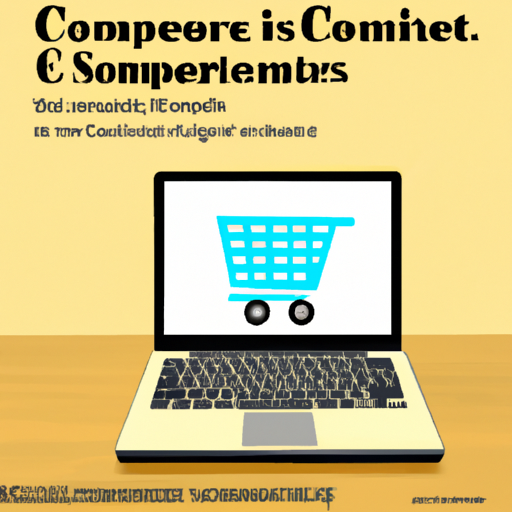Are you wondering if it’s possible to start an e-commerce store with little capital? Look no further! In this article, we will explore the exciting world of e-commerce and discuss how you can kickstart your online business even with limited funds. Not only that, but we will also uncover some fantastic product ideas that are perfect for those just starting out. So, if you’ve always dreamed of owning your own e-commerce store but thought it was out of reach, get ready to be inspired and discover how you can turn your entrepreneurial dreams into a reality!
Building an E-commerce Store with Little Capital
Starting an e-commerce store with limited funds is not only possible but also increasingly popular. With the rise of technology and the internet, it has become easier for individuals and small businesses to enter the world of online retail. In this article, we will explore various strategies and tools that can help you build an e-commerce store with little capital.

Click Here To CheckOut Entrepreneurship Business Reviews
Choosing the Right Platform
When starting an e-commerce store, one of the first decisions you need to make is choosing the right platform. There are several options available, ranging from fully hosted platforms to self-hosted solutions. Each option has its pros and cons, and the choice largely depends on your specific needs and budget.
Fully hosted platforms like Shopify and BigCommerce offer simplicity and ease of use. These platforms provide all the necessary features and take care of the technical aspects, such as hosting and security. While these platforms may have a monthly fee, they often provide value for money and are a great option for beginners or those with limited technical knowledge.
On the other hand, self-hosted solutions like WooCommerce and Magento give you more control over your store and allow for greater customization. While these platforms may require more technical expertise, they can be more cost-effective in the long run, as they often have lower monthly fees and provide the ability to scale your store as it grows.
Cost-Effective Website Design and Development
Designing and developing a website for your e-commerce store can be expensive if you hire a professional web designer or developer. However, there are several cost-effective alternatives that can help you create a visually appealing and user-friendly website.
One option is to use pre-designed website templates. Many e-commerce platforms, such as Shopify, offer a variety of free and paid templates that you can customize to fit your brand. These templates are often designed by professionals and are optimized for e-commerce functionality, saving you both time and money.
Another option is to use website builders like Wix or Squarespace. These platforms offer drag-and-drop interfaces and provide a wide range of customizable templates. While they may have a monthly fee, they eliminate the need for hiring a web developer and allow you to easily update and manage your website.
Lastly, if you have some technical knowledge, you can consider learning to code and building your website from scratch. There are many online resources and tutorials available that can help you learn HTML, CSS, and JavaScript, the essential languages for web development. While this option may require more time and effort, it can save you money in the long term.
Optimizing Website for Mobile Devices
With the increasing use of smartphones and tablets, it is essential to optimize your e-commerce website for mobile devices. A mobile-friendly website not only provides a better user experience but also improves your search engine rankings.
To optimize your website for mobile devices, you can take several steps. First, choose a responsive web design that automatically adjusts to different screen sizes. This ensures that your website looks and functions well on all devices, from smartphones to large desktop monitors.
Second, optimize your website’s loading speed. Mobile users have little patience for slow-loading websites, so ensure that your pages load quickly. Compress images, minimize code, and use caching techniques to speed up your website.
Third, make sure your website’s navigation and checkout process are easy to use on mobile devices. Simplify menus, buttons, and forms to provide a seamless experience for mobile users.
Lastly, test your website on various mobile devices and browsers to ensure compatibility. Take into consideration different screen sizes, operating systems, and browsers to provide a consistent experience for all users.
Implementing Basic SEO Strategies
Search engine optimization (SEO) is crucial for driving organic traffic to your e-commerce store. By optimizing your website for search engines, you can increase your visibility and attract potential customers.
Start by conducting keyword research to identify the terms and phrases that your target audience uses to search for products similar to yours. Use these keywords strategically throughout your website’s content, including product descriptions, category pages, and blog posts.
Optimize your website’s meta tags, including the title tag and meta description, to improve your search engine rankings. These tags should accurately describe your page’s content and include relevant keywords.
Ensure that your website’s URLs are search engine friendly. Use descriptive URLs that include keywords related to the page’s content. Avoid using generic URLs that don’t provide any information about the page.
Build high-quality backlinks to your website. Backlinks are links from other websites that point to your site. They act as a vote of confidence for search engines and can improve your search engine rankings. Reach out to other websites in your industry and ask if they would be interested in linking to your website.
Regularly update your website’s content. Search engines favor websites that regularly produce fresh and relevant content. Consider adding a blog to your e-commerce store and regularly publish informative and engaging articles related to your industry.

Using Free or Low-Cost E-commerce Tools
To build and operate an e-commerce store with little capital, it’s important to take advantage of free or low-cost e-commerce tools available. These tools can help you save money while still providing the necessary functionality for your store.
One popular free e-commerce platform is WooCommerce. It is a plugin for WordPress that allows you to turn any WordPress website into an online store. WooCommerce provides a wide range of features, including product management, payment gateways, and shipping options, making it a cost-effective option for small businesses.
Another cost-effective option is OpenCart. It is an open-source e-commerce platform that is easy to install and use. OpenCart provides a variety of themes and extensions that can enhance your store’s functionality. While some extensions may require a one-time fee, OpenCart itself is free to use.
Another important tool for e-commerce stores is a reliable payment gateway. PayPal is a popular choice for small businesses, as it is widely recognized and trusted by customers. It offers both free and paid plans, depending on your specific needs. Stripe is another popular payment gateway that offers competitive rates and supports a wide range of currencies.
For inventory management, consider using free software like Zoho Inventory or odoo. These tools help you keep track of your stock, manage orders, and automate various aspects of your e-commerce business.
Outsourcing Certain Tasks
When starting an e-commerce store with little capital, it’s important to focus on tasks that directly generate revenue. For other tasks that are not within your expertise or require significant time investment, consider outsourcing them to freelancers or agencies.
One task that can be outsourced is website design and development. If you don’t have the technical skills or time to create a professional-looking website, hire a web designer or developer to do it for you. You can find freelancers on platforms like Upwork or Fiverr who offer their services at affordable rates.
Content creation is another task that can be outsourced. If you are not confident in your writing skills or simply don’t have the time to create high-quality content, hire a freelance writer or copywriter to write product descriptions, blog posts, and other content for your e-commerce store.
Digital marketing and advertising are also tasks that can be outsourced. From managing social media accounts to running paid advertising campaigns, there are many agencies and freelancers available who specialize in digital marketing. Outsourcing these tasks can be cost-effective and allow you to focus on other aspects of your business.

Managing Inventory on a Small Budget
Managing inventory can be a challenge for e-commerce stores, especially when working with a limited budget. However, there are strategies and tools that can help you efficiently manage your inventory without breaking the bank.
One cost-effective inventory management strategy is dropshipping. Dropshipping is a business model where the retailer does not keep the products in stock. Instead, when a customer places an order, the retailer purchases the product from a third-party supplier, who then ships it directly to the customer. This eliminates the need for upfront inventory investment and reduces the risk of holding onto unsold products.
Another strategy is to start with a small inventory. Instead of stocking a wide range of products, focus on a few select products that are likely to sell well. This minimizes the upfront investment and allows you to test the market before committing to larger inventory quantities.
Implementing an inventory management system can also help you keep track of your stock and avoid overstocking or stockouts. There are several affordable or free inventory management tools available, such as Zoho Inventory or odoo, that can help you streamline your inventory management processes.
Consider working with suppliers who offer low minimum order quantities. This allows you to order smaller quantities of products and reduce the risk of being stuck with unsold inventory. Look for suppliers who specialize in working with small businesses or offer dropshipping services.
Monitor your inventory levels and sales data regularly. By analyzing your sales patterns and inventory turnover, you can identify products that are not selling well and adjust your inventory levels accordingly. This helps you avoid tying up capital in slow-moving products and focus on those that generate revenue.
Utilizing Affordable Marketing and Advertising Methods
Effective marketing and advertising are essential for driving traffic and sales to your e-commerce store. However, traditional marketing and advertising methods can be expensive. To build an e-commerce store with little capital, it’s important to utilize affordable marketing and advertising methods.
Social media marketing is a cost-effective way to promote your e-commerce store. Create business accounts on popular social media platforms like Facebook, Instagram, and Twitter, and regularly post engaging content to attract and engage with your target audience. Use social media advertising options to reach a wider audience and target specific demographics.
Content marketing is another affordable marketing strategy. Create informative and valuable content related to your industry and share it on your website or blog. This helps establish your brand as an authority in the industry and can attract potential customers through search engine rankings and social sharing.
Email marketing is a highly effective and affordable marketing method for e-commerce stores. Collect email addresses from your customers and website visitors and send them regular newsletters or promotional offers. Use email marketing software like Mailchimp or Sendinblue to automate your email campaigns and track their effectiveness.
Partnering with influencers or bloggers in your industry can also be a cost-effective way to reach a larger audience. Identify influencers who align with your brand and target demographics, and explore opportunities for collaboration, such as product reviews or sponsored posts.
Lastly, take advantage of free online directories and marketplaces to promote your e-commerce store. List your store on platforms like Google My Business, Yelp, and niche-specific directories to increase your online visibility and attract potential customers.

Providing Excellent Customer Service
Providing excellent customer service is crucial for the success of any e-commerce store, regardless of the budget. Happy and satisfied customers are more likely to become repeat customers and recommend your store to others.
Start by offering multiple channels for customer support, such as email, live chat, and phone. Make it easy for customers to contact you and provide prompt responses to their inquiries or issues. Use customer support software like Zendesk or LiveChat to manage customer inquiries more efficiently.
Personalize the shopping experience for your customers. Use their names in email communications, recommend products based on their browsing or purchase history, and offer personalized discounts or promotions. This helps create a connection with your customers and makes them feel valued.
Offer a clear and user-friendly return policy. Make it easy for customers to return or exchange products and provide clear instructions on how to do so. A hassle-free return policy builds trust with your customers and encourages them to make a purchase with confidence.
Regularly collect and analyze customer feedback. Encourage your customers to leave reviews or ratings on your website or other review platforms. Use this feedback to improve your products, customer service, and overall shopping experience.
Monitoring and Analyzing Performance Metrics
To continuously improve your e-commerce store and make informed business decisions, it’s important to monitor and analyze performance metrics. By tracking key metrics, you can identify areas of improvement, capitalize on your strengths, and make data-driven decisions.
Start by tracking basic metrics like website traffic, conversion rate, and average order value. Google Analytics is a free tool that can provide valuable insights into your website’s performance. It allows you to track user behavior, traffic sources, and conversion rates, among other metrics.
Monitor sales and revenue data to understand your store’s profitability and identify trends. Break down sales data by product, category, or customer segment to determine which areas of your store are performing well and which ones need improvement.
Track customer acquisition and retention rates. Understand where your customers are coming from and which marketing channels are driving the most sales. Also, monitor customer retention rates to identify any issues with your products or customer service that may be causing customers to churn.
Analyze cart abandonment rates to identify any barriers or issues during the checkout process. Use this data to optimize your website’s user experience, simplify the checkout process, and reduce cart abandonment.
Regularly review your marketing and advertising metrics. Track the performance of your social media campaigns, email marketing campaigns, and other advertising efforts. Identify which channels are generating the highest ROI and allocate your marketing budget accordingly.
In conclusion, building an e-commerce store with little capital is possible with the right strategies and tools. Choose the right platform, optimize your website for mobile devices, implement basic SEO strategies, utilize free or low-cost e-commerce tools, outsource certain tasks, manage inventory efficiently, utilize affordable marketing methods, provide excellent customer service, and monitor and analyze performance metrics. With careful planning and execution, you can build a successful e-commerce store without breaking the bank.




